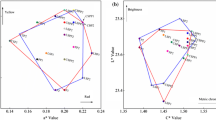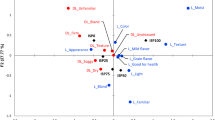Abstract
The emulsion sausages were prepared with industrially brewed soy sauce at levels of 0, 1, 3, and 5%, and were additionally prepared with two further types of soy sauce (mixed and Korean traditional soy sauces) at a concentration of 1%. Soy sauce increased the satisfaction for flavor and saltiness of emulsion sausages. Addition of 1% soy sauce improved the overall acceptance without adverse effect on physicochemical and textural properties. From the results of electronic nose analysis, soy sauce results in an increased peak intensity of the emulsion sausages. In principal component analysis, clusters of emulsion sausages formulated with Korea traditional soy sauce and industrially brewed soy sauce were clearly distinct from the control (without soy sauce). Thus, our study suggested that addition of 1% soy sauce could be effective for improving the flavor of emulsion sausages, and the effects are highly dependent on the type of soy sauce used.
Similar content being viewed by others
References
Wang H, Jenner AM, Lee CY, Shui G, Tang SY, Whiteman M, Wenk MR, Halliwell B. The identification of antioxidants in dark soy sauce. Free Radical Res. 41: 479–488 (2007)
Aoshima H, Ooshima S. Anti-hydrogen peroxide activity of fish and soy sauce. Food Chem. 112: 339–343 (2009)
Kobayashi M, Matsushita H, Tsukiyama R, Saito M, Sugita T. Shoyu polysaccharides from soy sauce improve quality of life for patients with seasonal allergic rhinitis: A double-blind placebocontrolled clinical study. Int. J. Mol. Med. 15: 463–467 (2005)
Moon GS, Cheigh HS. Antioxidative characteristics of soybean sauce in lipid oxidation process. Korean J. Food Sci. Technol. 19: 537–542 (1987)
Tsuchiya H, Sato M, Watanabe I. Antiplatelet activity of soy sauce as functional seasoning. J. Agr. Food Chem. 47: 4167–4174 (1999)
Kinoshita E, Yamakoshi J, Kikuchi M. Purification and identification of an angiotensin I-converting enzyme inhibitor from soy sauce. Biosci. Biotech. Bioch. 57: 1107–1110 (1993)
Lee SM, Seo BC, Kim YS. Volatile compounds in fermented and acid-hydrolyzed soy sauces. J. Food Sci. 71: C146–C156 (2006)
Kim JK, Chung YG, Yang SH. Effective components on the taste of ordinary Korean soy sauce. Microbiol. Biotechnol. Lett. 13: 285–287 (1985)
Park HK, Sohn KH, Park OJ. Analysis of significant factors in the flavor of traditional Korean soy sauce (III)-Aroma compound analysis-. J. Korean Soc. Food Cult. 12: 173–182 (1997)
Feiner G. Meat Products Handbook: Practical Science and Technology. Woodhead Publishing, Abington, Cambridge, England. pp. 239–285 (2006)
Ruusunen M, Puolanne E. Reducing sodium intake from meat products. Meat Sci. 70: 531–541 (2005)
Desmond E. Reducing salt: A challenge for the meat industry. Meat Sci. 74: 188–196 (2006)
Kremer S, Mojet J, Shimojo R. Salt reduction in foods using naturally brewed soy sauce. J. Food Sci. 74: S255–S262 (2009)
McGough MM, Sato T, Rankin SA, Sindelar JJ. Reducing sodium levels in frankfurters using naturally brewed soy sauce. Meat Sci. 91: 69–78 (2012)
Kim HW, Choi YS, Choi JH, Kim HY, Hwang KE, Song DH, Lee SY, Lee MA, Kim CJ. Antioxidant effects of soy sauce on color stability and lipid oxidation of raw beef patties during cold storage. Meat Sci. 95: 641–646 (2013)
Kim HW, Choi YS, Choi JH, Kim HY, Lee MA, Hwang KE, Song DH, Lim YB, Kim CJ. Tenderization effect of soy sauce on beef M. biceps femoris. Food Chem. 139: 597–603 (2013)
Choi YS, Choi JH, Han DJ, Kim HY, Lee MA, Kim HW, Lee JW, Chung HJ, Kim CJ. Optimization of replacing pork back fat with grape seed oil and rice bran fiber for reduced-fat meat emulsion systems. Meat Sci. 84: 212–218 (2010)
Bourne MC. Texture profile analysis. Food Technol. 32: 62–66 (1978)
Meilgaard M, Civille GV, Carr BT. Sensory Evaluation Techniques. 3rd ed. CRC Press, Boca Raton, FL, USA. p. 354 (1999)
Kim G, Lee KJ, Choi KH, Choi DS, Son JR, Kang S, Chang YC. Odor analysis for beef freshness estimation with electronic nose. J. Biosyst. Eng. 29: 317–322 (2004)
Kim JK, Kim CS. The taste components of ordinary Korean soy sauce. J. Korean Soc. Appl. Bi. 23: 89–105 (1980)
Kim HW, Choi JH, Choi YS, Kim HY, Han DJ, Kim TH, Lee SK, Kim CJ. Effects of salt concentration in soybean sauce on the physicochemical properties of pre-rigor ground Hanwoo muscle. Korean J. Food Sci. An. 31: 389–397 (2011)
Ishioroshi M, Samejima K, Yasui T. Heat-induced gelation of myosin: Factors of pH and salt concentrations. J. Food Sci. 44: 1280–1284 (1979)
García-Esteban M, Ansorena D, Gimeno O, Astiasarán I. Optimization of instrumental colour analysis in dry-cured ham. Meat Sci. 63: 287–292 (2003)
Dvorak P, Musilova H, Svarcova I. On-line measurements of colour of pork. Fleischwirtschaft Int. Mag. 81: 89–91 (2001)
Kim YA, Kim H, Chung MJ. Physicochemical analysis of Korean traditional soy sauce and commercial soy sauce. Korean J. Food Cook. Sci. 12: 273–279 (1996)
Seo SH, Hwang IK, Yang HS, Lee HJ. Studies on the odor components and sensory characteristics of Korean traditional soy sauces. Korean Soybean Dig. 12: 21–32 (1995)
Cho YS, Noh BS. Quality evaluation of dried laver (Porphyra yezoensis Ueda) using electronic nose based on metal oxide sensor or GC with SAW sensor during storage. Korean J. Food Sci. Technol. 34: 947–953 (2002)
Author information
Authors and Affiliations
Corresponding author
Rights and permissions
About this article
Cite this article
Kim, HW., Hwang, KE., Song, DH. et al. Effect of soy sauce type on the quality characteristics of emulsion sausages. Food Sci Biotechnol 24, 1309–1315 (2015). https://doi.org/10.1007/s10068-015-0168-y
Received:
Revised:
Accepted:
Published:
Issue Date:
DOI: https://doi.org/10.1007/s10068-015-0168-y




